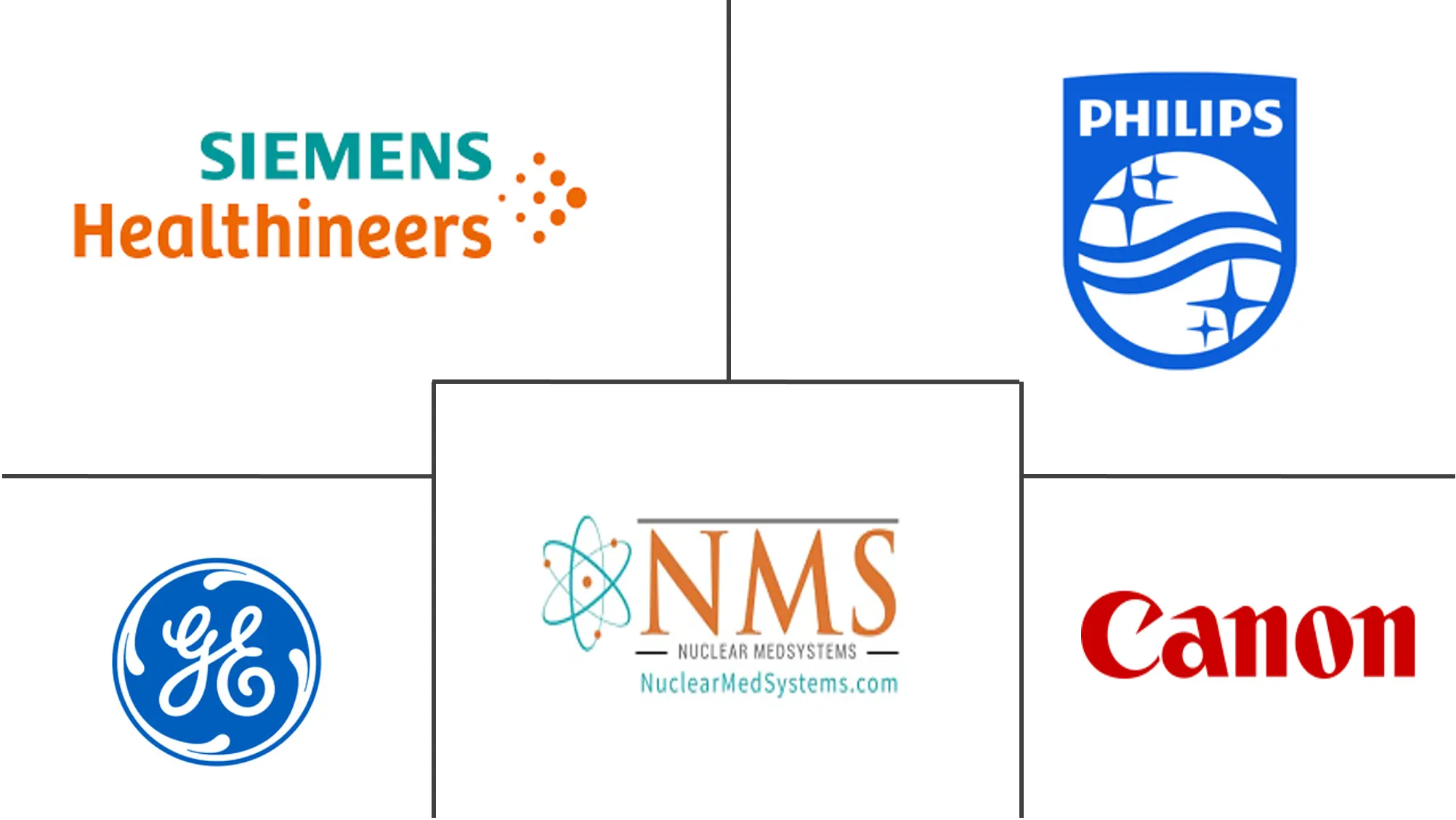Market Size of Asia Pacific Nuclear Imaging Industry

| Study Period | 2019 - 2029 |
| Base Year For Estimation | 2023 |
| Forecast Data Period | 2024 - 2029 |
| Market Size (2024) | USD 1.52 Billion |
| Market Size (2029) | USD 1.88 Billion |
| CAGR (2024 - 2029) | 4.23 % |
Major Players
*Disclaimer: Major Players sorted in no particular order |
APAC Nuclear Imaging Devices Market Analysis
The Asia Pacific Nuclear Imaging Market size is estimated at USD 1.52 billion in 2024, and is expected to reach USD 1.88 billion by 2029, growing at a CAGR of 4.23% during the forecast period (2024-2029).
The factors that are propelling the growth of the market include technological advancements, increasing diagnostic applications in various diseases, such as cancer and cardiovascular diseases, and the growing burden of these chronic diseases.
Over recent years, scientists, researchers, and technologists have been able to bring systems in clinical practice, in which two or even more than two standalone diagnostic imaging modalities are combined. Some of those multimodality imaging systems include PET/CT, SPECT/CT, PET/MRI, and PET/SPECT/CT. The shift from standalone to hybrid modalities have improved the applications of these devices in recent times.
Moreover, the rise in the prevalence of cancer and cardiac ailments is one of the primary drivers for the market. Nuclear medicine is hugely capable of treating cancer and cardiac diseases. Asia Pacific region has the highest populous countries like China and India, which in turn contribute to a large aging population. There is also a higher disease incidence in this region increases the demand for advanced technologies like nuclear imaging. There is a large investment on the healthcare setup and medical research making these facilities accessible. The per capita income is increasing in these countries making such technologies more affordable.
APAC Nuclear Imaging Devices Industry Segmentation
Nuclear medicine imaging procedures are non-invasive, with the exception of intravenous injections, and are usually painless medical tests that help physicians diagnose and evaluate medical conditions. These imaging scans use radioactive materials called radiopharmaceuticals or radiotracers. These radiopharmaceuticals are used in diagnosis and therapeutics. They are small substances that contain a radioactive substance that is used in the treatment of cancer, cardiac and neurological disorders.
| By Product Type | ||||||||||||||
| Equipment | ||||||||||||||
|
| By Application | ||||||
| ||||||
|
| Geography | ||||||||
|
Asia Pacific Nuclear Imaging Market Size Summary
The Asia Pacific nuclear imaging devices market is poised for significant growth, driven by technological advancements and an increasing number of diagnostic applications for diseases such as cancer and cardiovascular conditions. The transition from standalone diagnostic imaging modalities to hybrid systems, such as PET/CT and SPECT/CT, has enhanced the functionality and application of these devices. This shift is particularly beneficial in the Asia Pacific region, where the prevalence of chronic diseases is rising, fueled by a large aging population in populous countries like China and India. The region's investment in healthcare infrastructure and medical research, coupled with rising per capita income, is making advanced nuclear imaging technologies more accessible and affordable.
The market is characterized by intense competition, with major players like Koninklijke Philips NV, GE Healthcare, and Siemens Healthineers holding significant market shares. These companies are at the forefront of providing advanced imaging solutions that are crucial for diagnosing and treating cardiovascular diseases, which are a leading cause of mortality in countries like India. The use of gamma cameras and positron emission tomography scanners in cardiac procedures underscores the importance of nuclear imaging in managing cardiovascular health. As the prevalence of cardiovascular diseases continues to rise, the demand for nuclear imaging equipment is expected to grow, further propelling the market's expansion in the region.
Asia Pacific Nuclear Imaging Market Size - Table of Contents
-
1. MARKET DYNAMICS
-
1.1 Market Overview
-
1.2 Market Drivers
-
1.2.1 Rise in Prevalence of Cancer and Cardiac Disorders
-
1.2.2 Increase in Technological Advancements
-
-
1.3 Market Restraints
-
1.3.1 Limited Reimbursement and Stringent Regulatory Procedures
-
-
1.4 Porter's Five Force Analysis
-
1.4.1 Threat of New Entrants
-
1.4.2 Bargaining Power of Buyers/Consumers
-
1.4.3 Bargaining Power of Suppliers
-
1.4.4 Threat of Substitute Products
-
1.4.5 Intensity of Competitive Rivalry
-
-
-
2. MARKET SEGMENTATION
-
2.1 By Product Type
-
2.1.1 Equipment
-
2.1.2 Radioisotope
-
2.1.2.1 SPECT Radioisotopes
-
2.1.2.1.1 Technetium-99m (TC-99m)
-
2.1.2.1.2 Thallium-201 (TI-201)
-
2.1.2.1.3 Gallium(Ga-67)
-
2.1.2.1.4 Iodine (I-123)
-
2.1.2.1.5 Other SPECT Radioisotopes
-
-
2.1.2.2 PET Radioisotopes
-
2.1.2.2.1 Fluorine-18 (F-18)
-
2.1.2.2.2 Rubidium-82 (RB-82)
-
2.1.2.2.3 Other PET Radioisotopes
-
-
-
-
2.2 By Application
-
2.2.1 SPECT Applications
-
2.2.1.1 Cardiology
-
2.2.1.2 Neurology
-
2.2.1.3 Thyroid
-
2.2.1.4 Other SPECT Applications
-
-
2.2.2 PET Applications
-
2.2.2.1 Oncology
-
2.2.2.2 Cardiology
-
2.2.2.3 Neurology
-
2.2.2.4 Other PET Applications
-
-
-
2.3 Geography
-
2.3.1 Asia-Pacific
-
2.3.1.1 China
-
2.3.1.2 Japan
-
2.3.1.3 India
-
2.3.1.4 Australia
-
2.3.1.5 South Korea
-
2.3.1.6 Rest of Asia-Pacific
-
-
-
Asia Pacific Nuclear Imaging Market Size FAQs
How big is the Asia Pacific Nuclear Imaging Market?
The Asia Pacific Nuclear Imaging Market size is expected to reach USD 1.52 billion in 2024 and grow at a CAGR of 4.23% to reach USD 1.88 billion by 2029.
What is the current Asia Pacific Nuclear Imaging Market size?
In 2024, the Asia Pacific Nuclear Imaging Market size is expected to reach USD 1.52 billion.

